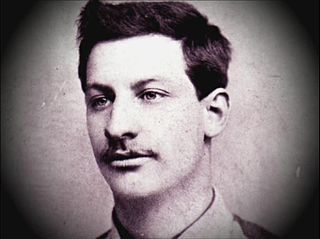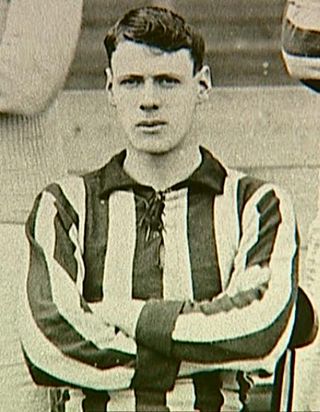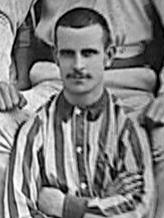Related Research Articles

William Isiah Bassett was an English association footballer, director, and club chairman who served West Bromwich Albion for over half a century.
Derek Tennyson Kevan was an English footballer. He spent the majority of his club career playing as a centre-forward for West Bromwich Albion, where he earned the nickname "The Tank". In 1961–62 he was joint leading scorer in Division One – alongside Ray Crawford of Ipswich Town – with 33 goals. He also won 14 caps for the England national team, scoring a total of eight goals, including two in the 1958 FIFA World Cup Finals.
Charles Perry was an English football centre-half who played for West Bromwich Albion and England.

Charles "Chippy" Simmons was an English footballer who played as a centre-forward.
Thomas Pearson was an English footballer who played at inside-left.

Albert Edward James Matthias Bayliss, known as Jem Bayliss, was an English footballer who played for West Bromwich Albion, as well as the England national side.
Adam Seymour Haywood was an English footballer who played as an inside-forward. Some sources spell his surname as Heywood or Hayward.

Joseph James Wilson was an English footballer who played at outside left. During his 15-year playing career he represented several teams from the West Midlands region, both as an amateur and a professional. He gained an FA Cup winners medal with West Bromwich Albion and was the scorer of the club's first ever goal in The Football League.
George Timmins was an English footballer who played at left-half. George Timmins signed for West Bromwich Albion in 1880, turning professional in August 1885. From August 1885 through to April 1888, the last three seasons before the Football League commenced George Timmins was part of three FA Cup Final teams 1885 – 1888. He obtained a Winner's medal in 1888 when the Albion defeated Preston North End 2–1 in the Final.
George "Spry" Woodhall was an English footballer, who played most of his career with West Bromwich Albion, helping them to reach three consecutive FA Cup finals, including winning the cup in 1888.
Harold Green was an English footballer who played at both right and left full-back.
The 1885–86 season was the eighth season in the history of West Bromwich Albion Football Club. In what was their inaugural season as a professional club, Albion moved to the Stoney Lane ground after leaving their previous home at Four Acres. The team also changed the colour of its kit, wearing blue and white striped jerseys for the first time. As league football had not been introduced in England at the time, the team competed solely in cup competitions and friendly matches throughout the season, playing 52 matches in total.
George Bell was an English footballer who played at outside left. He was born in West Bromwich and worked at the local George Salter's Spring Works. Bell was one of the founders of the factory's football team, the West Bromwich Strollers, and played in the team's first recorded match, a 0–0 draw against Hudson's soap factory on 23 November 1878. He continued to play for the team following their change of name to West Bromwich Albion in 1879, playing alongside his cousin Harry Bell on several occasions.
The 1884–1885 season was 7th season of West Bromwich Albion Football Club. It was their third and final season at the Four Acres and their last season as an amateur club. Continuing the trial of various coloured kits during the club's early years, the players wore cardinal red and blue halved shirts. The club reached the FA Cup quarter-final for the first time, played in the semi-finals of the Staffordshire Senior Cup and Birmingham Charity Cup and were eliminated from the Birmingham Senior Cup at the third round stage.
Nathaniel Walton was an English international footballer, who played as an inside forward.
The 1888–89 season was the 11th season in the history of West Bromwich Albion, as well as their first season in the newly formed Football League, of which they were a founder member. They finished in 6th position with 22 points.
John Henry Horton was an English footballer who played in the English Football League and the 1895 FA Cup Final for West Bromwich Albion. He also played for Burslem Port Vale and Wednesbury Old Athletic. His brother Ezra was also a footballer, and was a teammate of many years at West Brom.
Charles Richard Shaw, known as Charlie Shaw, was an English footballer who played in the Football League for West Bromwich Albion.
Luther Walker was an English footballer who played in The Football League for West Bromwich Albion.
The 1887–88 season was the 10th season in the history of West Bromwich Albion Football Club. The club reached the FA Cup final for the third successive season and won the competition for the first time, beating Preston North End 2–1. Albion also competed in four local cup competitions, winning the Walsall Senior Cup and West Bromwich Charity Cup and finishing as runners-up in the Birmingham Senior Cup and Staffordshire Senior Cup. Due to a congested fixture list, the club refused to take part in the Birmingham Charity Cup.
References
- ↑ Joyce, Michael (2004). Football League Players' Records 1888 to 1939. SoccerData. p. 207. ISBN 1-899468-67-6.
- ↑ Matthews, Tony (2005). The Who's Who of West Bromwich Albion 1878 to 2005. Breedon Publishing. p. 177. ISBN 978-1-78091-154-0.
- ↑ Matthews, Tony (2005). The Who's Who of West Bromwich Albion 1878 to 2005. Breedon Publishing. p. 177. ISBN 978-1-78091-154-0.
- ↑ Metcalf, Mark (2013). The Origins of the Football League The First Season 1888/89. Amberley. p. 48. ISBN 978-1-4456-1881-4.
- ↑ "English National Football Archive" . Retrieved 26 April 2018. (registration & fee required)
- ↑ "English National Football Archive" . Retrieved 26 April 2018. (registration & fee required)
- ↑ Matthews, Tony (2005). The Who's Who of West Bromwich Albion 1878 to 2005. Breedon Publishing. p. 177. ISBN 978-1-78091-154-0.
